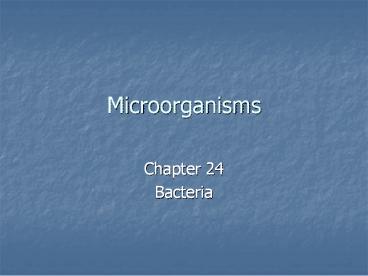Microorganisms - PowerPoint PPT Presentation
Title:
Microorganisms
Description:
Microorganisms Chapter 24 Bacteria – PowerPoint PPT presentation
Number of Views:202
Avg rating:3.0/5.0
Title: Microorganisms
1
Microorganisms
- Chapter 24
- Bacteria
2
Microorganisms Defined
- Microorganisms can be defined as those
unicellular and multi-cellular organisms too
small to be seen with the naked eye. - Microorganisms are thought to be the descendants
of the first living organisms on earth. - Microorganisms are thought to have started life
as ocean dwellers that utilized organic nutrients
gathered from the ocean for their existence.
3
Microorganisms Defined
- Evidence suggests that these first organisms were
small, uncomplicated, lacked membrane bound
organelles and did not have a nucleus.
4
Classification of Microorganisms
- In the 6 kingdom system the prokaryotes called
bacteria are grouped in 2 kingdoms - Eubacteria and Archaebacteria
- The kingdom Protista are composed of two major
types of organisms - Monerans and Algae
- The kingdom Fungi are made up of
- Molds, Yeasts and Lichens
5
Science of Microbiology
- Dedicated to the study of the organisms, their
relationship to other organisms and the
environment and the impact microbes have on the
health and well being of the human population.
6
Microbiologists
- Scientists who study Microbes and enable us to
develop an understanding of how microbes effect
our world. - Specialized by the type of microbe they study
- Bacteriologist-Bacteria
- Virologist-Viruses
- Mycologists-Fungi
7
Tools of the Microbiologist
- The main tools of the microbiologist are
- The light microscope
- Electron microscope
- Instruments used to grow microorganisms for study
- Incubators
- Petri Dishes
- Nutrient Agar
- Stains to locate and identify microorganisms
8
Kingdom Archaebacteria
- Make up group of bacteria called Extremeophiles.
Archaebacteria lack peptidoglycan in their cell
walls and posses unusual lipids in their cell
walls. - Methanogens-acquire energy from the conversion of
H2 and CO2 into methane gas. - Halophiles-salt loving bacteria, use salt to
generate ATP. - Thermoacidophiles-live in extreme acidic/hot
environments. (temperatures up to 230 F)
9
Kingdom Eubacteria
- 3 Basic Shapes
- Bacilli-bacteria that have rod shapes
- Cocci-Bacteria that are spherical in shape
- Spirilla-Bacteria that are spiral in shape
- Cocci that occur in chains are called
Streptococci and those that occur in bunches are
called Staphylococci
10
Kingdom Eubacteria
- Divided into 2 groups based on their response to
a technique called the Gram Stain. - Bacteria that stain purple are called Gram
Positive. - Bacteria that do not take up the stain and appear
pink are called Gram Negative. - These bacteria can also be differentiated by how
they respond to antibiotics.
11
Bacteria Groups -4 Phylum
- Cyanobacteria-Cyanobacteria use photosynthesis to
produce the energy that they need the by product
is oxygen. - Spirochetes-Spiral Shaped bacterium Treponema
pallidum responsible for the sexually transmitted
disease Syphilis - Gram Positive Bacteria-Actinomycetes grow in soil
and produce antibiotics that inhibit or kill
other organisms - Proteobacteria-Enteric (Escherichia coli)
- Chemoautotroph-extract energy from minerals and
gases - Example Rhizobium-Nitrogen fixing bacteria, get
energy from nitrogen gas in the atmosphere.
12
Bacterial Structure
- 1. Cell Wall-made up of peptidoglycan
- Cell Membrane and Cytoplasm
- Capsules and Pili
- Capsule- outer covering that protect it from
drying and harsh chemicals - Pili-hair like surface structure that help the
bacterium adhere to the cells of the host. Also
use to transfer genetic information from one
bacterium to another. - Endospore-thick outer covering that protects the
bacteria when exposed to harsh environmental
conditions.
13
Movement
- Flagella are use to move bacteria.
- Bacteria may have 1 or a tuft of flagella
- Spiral shaped bacteria use corkscrew movements
- Some bacteria secrete a slime coat to glide
through
14
Nutrition and Growth
- Bacteria may be heterotrophic or autotrophic.
- Autotrophs-Photoautotrophs obtain energy from the
sun. - Chemoautotroph-obtain energy from minerals in the
environment. - Heterotrophs
- Saprophytes-obtain energy from dead and decaying
material.
15
Oxygen Requirements
- Obligate Anaerobes-cannot live in the presence of
oxygen-Ex. Clostridium tetani - Facultative anaerobes-can live with or without
oxygen. - Obligate Aerobes-cannot survive without oxygen.
Ex. Mycobacterium tuberculosis
16
Genetic Recombination
- A. Transformation-DNA taken in from the external
environment. - B. Conjugation-Pilus connects two bacterium
forming Conjugation bridge for the exchange of
genetic material. - C. Transduction-Replication of DNA fragments
within a virus inside a bacterium.
17
Bacteria and Disease
- The study of diseases is called Pathology
- Bacteria cause disease by the release of poisons
called Toxins.
18
Bacterial Toxins-2 kinds
- Exotoxins-bacterial excretions into the
surrounding environment-Tetanus - Endotoxins-toxins released as result of the death
and disintegration of bacteria. Cause of body
ache, weakness and fever.
19
Antibiotics
- Antibiotics are drugs that destroy bacteria by
interfering with either the structure or
function of the bacterium - Two common antibiotics are
- Penicillin-bacterial cell wall synthesis
- Tetracycline-bacterial protein synthesis
20
Useful Bacteria
- Bacteria are used beneficially in
- Sewage treatment
- The recycling of dead organisms
- Processing foods
- Yogurt, Cheeses, Sour Cream, Alcoholic Beverages
- Pesticides
- Clean up of environmental disasters
21
(No Transcript)































